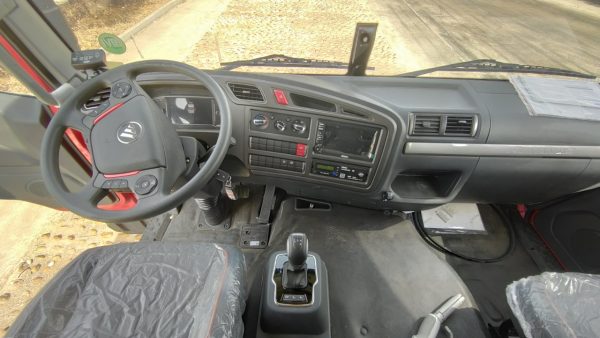The Powerhouse on Wheels Exploring the World of Truck Mounted Crane Engines

Introduction
Truck mounted cranes are an essential piece of equipment in various industries such as construction, transportation, and logistics. These powerful machines are capable of lifting and moving heavy loads with precision and efficiency. At the heart of these machines lies the truck mounted crane engine, a powerful and robust motor that provides the necessary power to operate the crane effectively. In this article, we will delve into the world of truck mounted crane engines, exploring their design, functionality, maintenance, and the latest advancements in technology.
History of Truck Mounted Crane Engines
Truck mounted cranes have been in use for centuries, with the earliest forms of cranes dating back to ancient civilizations. However, it wasn't until the 20th century that truck mounted cranes became popular in the construction industry. Boom truck maintenance schedule of powerful engines and hydraulics systems revolutionized the capabilities of these machines, allowing them to lift heavier loads and operate more efficiently.
Early truck mounted crane engines were typically powered by diesel or gasoline motors, providing the necessary torque and horsepower to lift and move heavy objects. As technology advanced, manufacturers began to develop more specialized engines specifically designed for truck mounted cranes, incorporating features such as variable displacement pumps, electronic controls, and emissions control systems.
Design and Functionality of Truck Mounted Crane Engines
Truck mounted crane engines are designed to provide the power and performance required to operate the crane effectively. These engines are typically mounted on the chassis of the truck and are connected to the crane's hydraulic system, which controls the movement of the crane's boom, jib, and winch.
The design of a truck mounted crane engine is crucial for its functionality and performance. These engines are built to withstand the rigors of heavy-duty use, with features such as reinforced blocks, high-strength pistons, and heavy-duty bearings. The engine's cooling system is also essential to prevent overheating during prolonged operation, with many modern engines incorporating advanced cooling technologies such as liquid cooling and variable speed fans.
One of the key components of a truck mounted crane engine is the hydraulic system, which converts the engine's mechanical power into hydraulic power to operate the crane's lifting and hoisting mechanisms. The hydraulic system consists of pumps, valves, cylinders, and hoses, all working together to control the movement of the crane's components with precision and accuracy.
Maintenance of Truck Mounted Crane Engines
Proper maintenance is essential to ensure the longevity and performance of a truck mounted crane engine. Regular maintenance checks and servicing can help prevent costly breakdowns and downtime, ensuring that the crane operates smoothly and efficiently.
Some key maintenance tasks for truck mounted crane engines include regular oil changes, filter replacements, and inspection of belts and hoses. It is also important to check the engine's cooling system for any leaks or blockages and ensure that the hydraulic system is functioning correctly.
In addition to regular maintenance, it is crucial to follow the manufacturer's guidelines for operating the crane and engine safely. Overloading the crane or operating it beyond its recommended capacity can lead to excessive wear and damage to the engine components, resulting in costly repairs and downtime.
Advancements in Truck Mounted Crane Engine Technology
Advancements in technology have led to significant improvements in the design and functionality of truck mounted crane engines. Manufacturers are constantly innovating to develop more efficient and environmentally friendly engines that meet the demands of modern construction and logistics industries.
One notable advancement in truck mounted crane engine technology is the integration of electronic control systems. These systems allow for more precise control of the engine's performance, optimizing fuel efficiency and reducing emissions. Electronic control systems also provide real-time diagnostics and monitoring capabilities, allowing operators to detect and address potential issues before they escalate.
Another key development in truck mounted crane engine technology is the use of hybrid powertrains. Hybrid engines combine traditional internal combustion engines with electric motors to improve fuel efficiency and reduce emissions. These hybrid systems are especially beneficial for crane operations that require frequent starts and stops, as the electric motor can provide instant torque for lifting heavy loads.

Furthermore, manufacturers are investing in research and development to explore alternative fuel options for truck mounted crane engines, such as natural gas and hydrogen fuel cells. These cleaner fuel sources offer a more sustainable and environmentally friendly alternative to traditional diesel and gasoline engines, reducing carbon emissions and promoting a greener future for the construction industry.
Conclusion
Truck mounted crane engines are the powerhouse behind these essential machines, providing the necessary power and performance to lift and move heavy loads with precision and efficiency. The design, functionality, maintenance, and advancements in technology of these engines play a crucial role in the operation of truck mounted cranes in various industries.
As technology continues to evolve, we can expect to see further innovations in truck mounted crane engine technology, with a focus on improving efficiency, reducing emissions, and enhancing overall performance. By staying abreast of the latest developments in this field, operators and manufacturers can ensure that truck mounted cranes remain at the forefront of modern construction and logistics practices.
